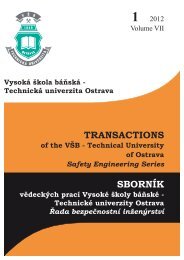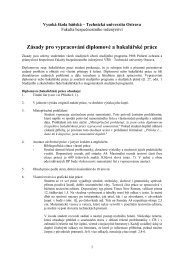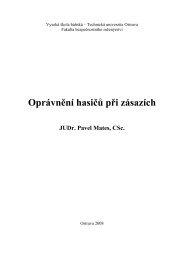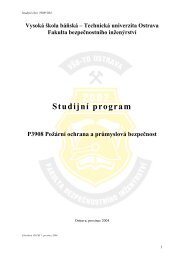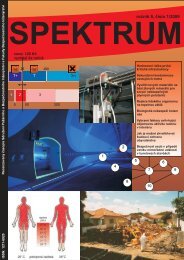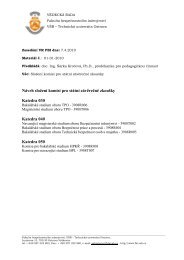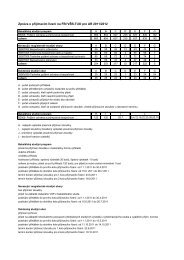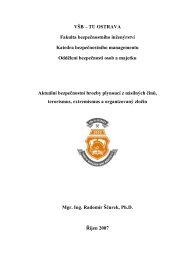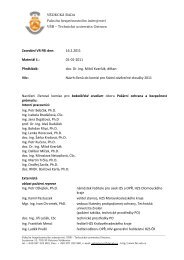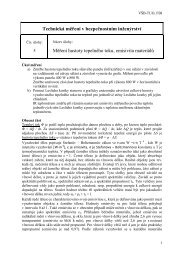Transactions - FBI - Vysoká Å¡kola báÅská - Technická univerzita ...
Transactions - FBI - Vysoká Å¡kola báÅská - Technická univerzita ...
Transactions - FBI - Vysoká Å¡kola báÅská - Technická univerzita ...
Create successful ePaper yourself
Turn your PDF publications into a flip-book with our unique Google optimized e-Paper software.
<strong>Transactions</strong> of the VŠB - Technical university of OstravaSafety Engineering SeriesVol. VI, No. 2, 2011p. 11 - 16this purpose, since they can be properly modified toincrease their sorption ability. Modified clay materialscan be used for the sorption both from aqueousmedia, when especially heavy metals (Cu, Ag, Cd,Pb, Zn, Hg etc.) are sorbed (Plee et al. 1985; Weisset al., 1998), and from gaseous media, to removethe dangerous volatile organic substances (benzene,toluene, xylene, naphthalene) (Houari et al, 2007;Ruiz et al., 1998). This approach represents very goodopportunity for practical applications, since 70 % ofmolds used today are bonded by uniform bentonitemixture. Modified bentonite mixtures could servedirectly for the removal of industrial pollutants.Two workplaces of the VŠB - TechnicalUniversity of Ostrava study the problems of claymaterials modification in the long term, namely theCentrum of nanotechnologies and the Departmentof analytical chemistry and testing of materials.The requirements for removing the pollutants fromfoundry process in foundries were defined in thecooperation with the Institute of foundry industry atTU Bergakademie Freiberg. The authors (Plachá, etal., 2008; Plachá, et al., 2011) studied the sorptionof naphthalene on vermiculite that was modifiedby hexadecyltrimethylamonia bromide or by themonohydrate of hexadecylpyridinium chloride - thisstudy was performed in the framework of the researchplan MSM 6198910016 “Synthesis, structure andproperties of nanomaterials based on intercalatedphylosilicates” (2005 - 2011, MSM). The project GP104/08/P274 - “The Study of properties and use ofclay materials after intercalation by inorganic andorganic cations (2008 - 2010, GA0/GP) was anotherresearch project in this field. Its solver deals, amongother things, with the intercalation of clay materialsby Keggin’s cation and with the sorption of organicmolecules (toluene and xylene) on intercalatedclay materials or the sorption of humic substanceson clays (Pavlovský et al., 2009; Pavlovský et al.,2010). The authors of this article relate closely tothis project, studying the sorption of dangerouspollutants from both the aquatic - Cr(VI) andgaseous media - toluene, xylene.Materials and methodsThe standard of the type SWy-2 (Na-richMontmorillonite-MMT, Crook County, Wyoming,USA) was chosen as a feedstock for the assessmentof the sorption abilities of modified clay materials.This sodium form of montmorillonite treatedby sedimentation in order to remove silicon outof the sample, with the following parameters:basal diffraction d 0011,21 nm, specific surfaceS 26,8 m 2 .g -1 , CEC (ion exchange capacity)1,21 meq.g -1 , particle size < 5 μm.The clay material was intercalated by thecommercial solution Chlorhydrol (Reheis company,USA, 50 % solution with the chemical compositionAl 2Cl(OH) 5. (2,5 H 2O), molar ratio OH/Al 2,5)and by humic substance (HS) Humagra ® Liquid10-4-6 (Humintech, GmbH Düsseldorf, Germany,potassium form HS (humic acids content - HA18 %, nitrogen (urea) 10 %, phosphoric oxide 4 %,potassium oxide dissolved 6 %, iron 0,2 %, pH 8 - 9,density 1,23 kg.dm -3 , CEC 300 - 500 meq/100 g).Activated carbon CS type (specific surface S1261,7 m2.g -1 , made from coconut shells, iodinenumber 1050 kg.m -3 , Endler Ltd., Děčín X-Bělá,Czech Republic) was chosen for the comparisonof the sorption of gaseous pollutants with commonsorbent.The following industrial pollutants were rankedamong the watched sorbed substances:- toluene, xylene (p.a., Merci Ltd., Czech Republic)for the gaseous phase sorption on pillarized andinorganically intercalated clay materials,- Cr(VI) for the sorption in the form of dichromates(K 2Cr 2O 7, p.a., Merci Ltd., CR) from the aqueousmedia on organically intercalated clay materials(Pavlovský et al., 2011).Modification of clay materialsMontmorillonite based clay materials are usedabundantly for sorption thanks to their propertiessuch as high specific surface and porosity. Thesematerials are modified for the improvement of theirsorption abilities. The following methods are mostoften used for modification:- pillarization,- inorganic intercalation,- organic intercalation.These modifications can be mutually combined,too (Lahav, et al., 1978; Michot et al., 1993;Kloprogge et al., 1999). Pillarization is a processwhen the clay material is heated to the temperature ofapprox. 450 °C. The structure change occurs at thistemperature (Fig. 1), which results into the increaseof interlaminar distance and of specific surfaceand the improvement of other texture parameters(pore size and distribution etc.). During inorganicintercalation, big inorganic molecules (e.g. Keggin’scation) penetrate into montmorillonite interlayer(Fig. 2) (Lambert et al., 1994). Intercalate preparedin this way again demonstrate increased interlaminardistance and specific surface (Moore et al., 1997).Nevertheless, the selectivity of sorbed substances ortheir subsequent degradation can be influenced by theselection of suitable molecule. Organic intercalation12



